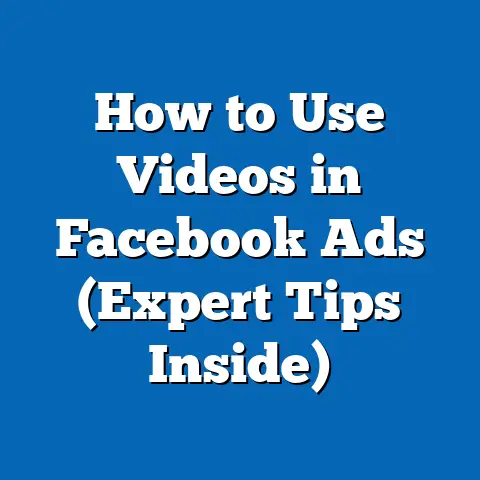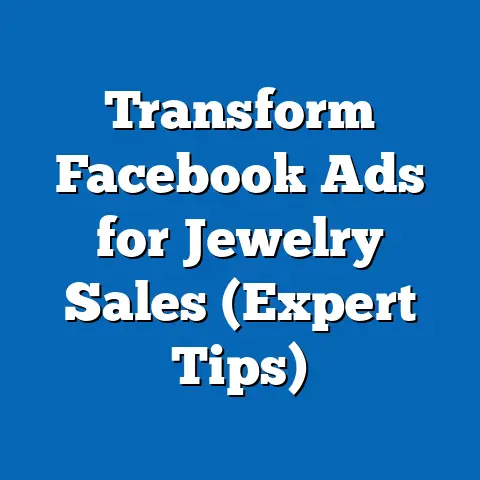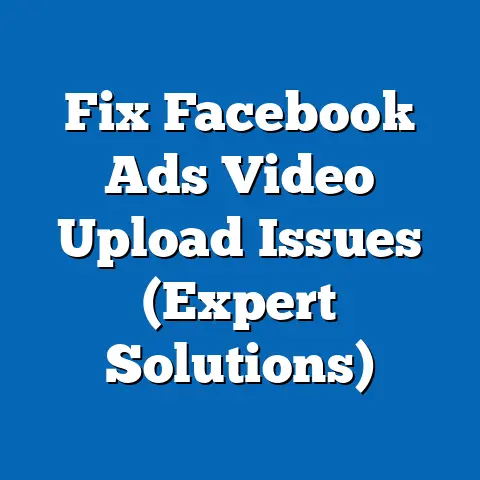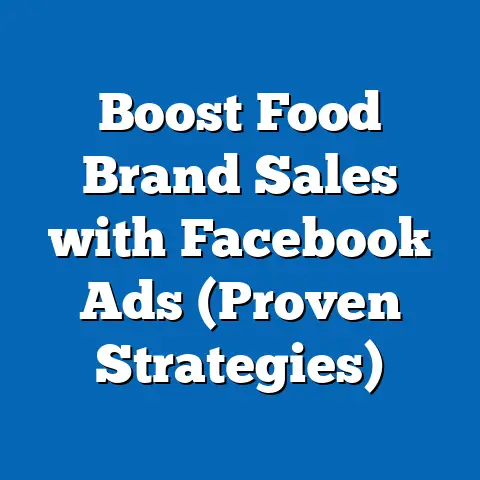Unlocking Facebook Ads: Essential Costs Explained (Must-Read Insights)
In today’s digital landscape, Facebook advertising has become an indispensable tool for businesses of all sizes. With billions of active users, Facebook offers unparalleled reach and targeting capabilities. However, navigating the world of Facebook ads can feel like venturing into uncharted territory, especially when it comes to understanding the costs involved. While the prospect of reaching a massive audience is exciting, many businesses find themselves overwhelmed by the complexities of ad spend, budgeting, and ROI.
The good news is, Facebook also offers low-maintenance advertising options that allow businesses with limited resources to still reach their audience effectively. Options like boosted posts and automated ad placements can be a great starting point. I remember when I first started experimenting with Facebook ads, I was completely lost. I threw money at campaigns with no clear strategy, and the results were predictably dismal. It was only after I took the time to understand the underlying cost structure that I started seeing real returns.
Understanding Facebook Ads
Before diving into the specifics of cost, it’s essential to have a solid understanding of what Facebook ads are and how they function.
Facebook ads are paid messages or promotions that businesses create and display on the Facebook platform. These ads can appear in various formats, including:
- Image Ads: Single image with accompanying text.
- Video Ads: Short video clips designed to capture attention.
- Carousel Ads: Multiple images or videos that users can scroll through.
- Slideshow Ads: A video-like ad created from a series of images.
- Collection Ads: Display a main image or video with several smaller product images.
- Instant Experience Ads: Full-screen, mobile-optimized ads that load instantly.
- Lead Ads: Allow users to submit their information directly through the ad.
What sets Facebook ads apart from other forms of advertising is their incredible targeting capabilities. Facebook allows you to target users based on a wide range of criteria, including:
- Demographics: Age, gender, location, education, relationship status.
- Interests: Hobbies, activities, pages liked, topics followed.
- Behaviors: Purchase history, online activity, device usage.
- Custom Audiences: Uploaded customer lists, website visitors, app users.
- Lookalike Audiences: Reach new people who are similar to your existing customers.
This granular targeting is what makes Facebook ads so powerful. By reaching the right audience with the right message, you can significantly improve your ad performance and ROI.
The Advertising Ecosystem
Facebook’s advertising ecosystem operates through an ad auction. When you create an ad, you’re essentially bidding for the opportunity to show it to your target audience. The ad auction takes into account several factors, including:
- Your Bid: The amount you’re willing to pay for each click or impression.
- Ad Relevance: How well your ad matches the interests of your target audience.
- Estimated Action Rates: The likelihood that your ad will generate the desired action (e.g., click, purchase, lead).
- Ad Quality: The overall quality of your ad creative and messaging.
The ad with the highest overall value wins the auction and gets shown to the user. This means that even if you have a lower bid, you can still win the auction if your ad is highly relevant and engaging.
Relevance Score: Facebook assigns a relevance score to each ad, based on its expected performance. A higher relevance score can lead to lower costs and better ad delivery. This score is based on the positive and negative feedback Facebook expects an ad to receive from its target audience. Ads that are more relevant to their audience will generally cost less and achieve better results.
Takeaway: Understanding the Facebook advertising ecosystem is crucial for managing costs effectively. By creating relevant, high-quality ads and targeting the right audience, you can improve your ad performance and lower your overall spend.
Cost Components of Facebook Ads
Now that we’ve covered the basics of Facebook ads, let’s delve into the specific cost components that you need to be aware of.
Ad Spend
The most obvious cost component is your ad spend, which is the amount you pay to run your ads on Facebook. This cost is primarily driven by two key metrics:
- Cost Per Click (CPC): The amount you pay each time someone clicks on your ad.
- Cost Per Impression (CPM): The amount you pay for every 1,000 impressions (times your ad is shown).
Which metric is more important depends on your campaign goals. If you’re focused on driving traffic to your website or landing page, CPC is the more relevant metric. If you’re focused on building brand awareness, CPM is a better indicator of your reach.
Factors Affecting CPC and CPM:
- Target Audience: Highly specific and niche audiences tend to have higher CPCs and CPMs due to increased competition. Conversely, broader audiences may have lower costs.
- Ad Placement: Different ad placements (e.g., Facebook News Feed, Instagram Stories, Audience Network) have different costs. News Feed placements generally have higher CPMs due to their visibility.
- Ad Relevance: As mentioned earlier, a higher relevance score can lead to lower costs.
- Industry: Some industries, such as finance and insurance, tend to have higher advertising costs due to increased competition and higher customer lifetime values.
- Time of Year: Advertising costs can fluctuate throughout the year, with higher costs during peak seasons like holidays and Black Friday.
Competition in the Ad Auction:
The ad auction is a dynamic process, and the level of competition can significantly impact pricing. When multiple advertisers are targeting the same audience, the cost of reaching that audience will increase. This is why it’s important to constantly monitor your ad performance and adjust your bids accordingly. I’ve seen firsthand how quickly costs can escalate when a new competitor enters the market or when a trending topic attracts a surge of advertisers.
Takeaway: Ad spend is a critical cost component of Facebook advertising, and it’s influenced by a variety of factors. By understanding these factors and monitoring your ad performance, you can optimize your ad spend and improve your ROI.
Budgeting Options
Facebook offers two main budgeting options:
- Daily Budget: The average amount you’re willing to spend each day on your ad campaign.
- Lifetime Budget: The total amount you’re willing to spend over the entire duration of your ad campaign.
Daily Budgets:
Daily budgets are ideal for ongoing campaigns that run continuously. Facebook will automatically adjust your daily spend based on performance, but it will never exceed your specified daily budget by more than 25%. For example, if you set a daily budget of $20, Facebook may spend up to $25 on some days, but it will ensure that your average daily spend remains close to $20.
Lifetime Budgets:
Lifetime budgets are best suited for campaigns with a specific end date, such as a product launch or a limited-time promotion. Facebook will automatically optimize your ad spend throughout the campaign duration to maximize results within your specified budget.
Setting Budgets Effectively:
Setting the right budget is crucial for achieving your advertising goals. Here are some tips for setting budgets effectively:
- Start Small: If you’re new to Facebook advertising, start with a small budget and gradually increase it as you learn what works. I always advise my clients to start small and test different ad creatives and targeting options before scaling their campaigns.
- Consider Your Target Audience Size: A smaller target audience may require a lower budget, while a larger audience may require a higher budget.
- Set Realistic Goals: Don’t expect to achieve massive results with a tiny budget. Set realistic goals based on your budget and adjust your expectations accordingly.
- Monitor Your Performance: Continuously monitor your ad performance and adjust your budget as needed. If your ads are performing well, you may want to increase your budget to reach more people. If your ads are underperforming, you may want to decrease your budget or pause your campaign altogether.
Understanding Your Target Audience:
As I mentioned earlier, understanding your target audience is crucial for managing costs effectively. The more specific and niche your target audience, the higher your advertising costs will likely be. This is because there’s more competition for reaching these audiences.
However, targeting a highly specific audience can also lead to better results. By reaching the right people with the right message, you can improve your ad relevance, click-through rates, and conversion rates.
Takeaway: Choosing the right budgeting option and setting budgets effectively are essential for managing your ad spend. By considering your target audience size, setting realistic goals, and monitoring your performance, you can optimize your budget and achieve your desired results.
Ad Creative Costs
In addition to your ad spend, you also need to factor in the costs associated with creating your ad creatives. These costs can include:
- Graphic Design: The cost of creating visually appealing images or graphics for your ads.
- Video Production: The cost of creating engaging video content for your ads.
- Copywriting: The cost of writing compelling ad copy that captures attention and drives action.
- Photography: The cost of professional photography for your product or service.
The cost of ad creative can vary widely depending on the quality and complexity of the content. You can create simple image ads using free online tools, or you can hire a professional graphic designer to create more sophisticated visuals. Similarly, you can create basic video ads using your smartphone, or you can hire a professional video production company to create high-quality video content.
The Importance of High-Quality Creative:
While it may be tempting to cut corners on ad creative costs, it’s important to remember that your ad creative is often the first impression you make on potential customers. High-quality creative can significantly improve your ad performance and lower your overall costs.
Ads with visually appealing images or videos and compelling ad copy are more likely to capture attention, generate clicks, and drive conversions. This, in turn, can improve your ad relevance score and lower your CPC and CPM.
I’ve seen countless examples of businesses that transformed their Facebook ad performance simply by investing in better ad creative. It’s often the single biggest factor in determining the success or failure of a campaign.
Takeaway: Ad creative costs are an important consideration when budgeting for Facebook advertising. Investing in high-quality creative can improve your ad performance, lower your overall costs, and ultimately drive better results.
Additional Costs to Consider
Beyond the direct costs of ad spend and creative, there are several other potential costs to consider when budgeting for Facebook advertising.
Landing Page Costs
Your landing page is the page that users are directed to after clicking on your ad. The quality of your landing page can have a significant impact on your conversion rates, which in turn can affect your ad spend.
Costs Associated with Creating Optimized Landing Pages:
- Design: The cost of designing a visually appealing and user-friendly landing page.
- Development: The cost of developing the landing page and ensuring it’s mobile-responsive.
- Hosting: The cost of hosting the landing page on a reliable web server.
- Copywriting: The cost of writing compelling landing page copy that drives conversions.
A/B Testing:
A/B testing is the process of testing different versions of your landing page to see which one performs better. This can involve testing different headlines, images, calls to action, and layouts.
A/B testing can be a valuable tool for improving your conversion rates and lowering your ad spend. By identifying the elements that resonate with your audience, you can optimize your landing page for maximum performance.
Takeaway: Landing page costs are an important consideration when budgeting for Facebook advertising. Investing in an optimized landing page can improve your conversion rates and lower your overall costs.
Management Fees
If you don’t have the time or expertise to manage your Facebook ad campaigns in-house, you may want to consider hiring an ad agency or freelancer to manage your campaigns for you.
Costs Related to Hiring Ad Agencies or Freelancers:
- Management Fees: The fees charged by ad agencies or freelancers for managing your ad campaigns. These fees can be a percentage of your ad spend or a fixed monthly fee.
- Setup Fees: Some agencies or freelancers may charge a setup fee for creating your ad campaigns.
- Reporting Fees: Some agencies or freelancers may charge a reporting fee for providing you with regular performance reports.
Pros and Cons of Outsourcing vs. Managing Campaigns In-House:
Outsourcing:
- Pros: Access to expertise and experience, saves time and resources, can scale campaigns quickly.
- Cons: Can be expensive, loss of control, potential communication barriers.
Managing Campaigns In-House:
- Pros: More control, lower costs, better understanding of your business.
- Cons: Requires time and expertise, can be challenging to scale campaigns quickly.
I’ve worked with clients who have had both positive and negative experiences with outsourcing their Facebook ad management. The key is to find an agency or freelancer who understands your business goals, communicates effectively, and has a proven track record of success.
Takeaway: Management fees are an important consideration when budgeting for Facebook advertising. Weigh the pros and cons of outsourcing vs. managing campaigns in-house to determine the best approach for your business.
Measuring Return on Investment (ROI)
Measuring your return on investment (ROI) is crucial for evaluating the effectiveness of your Facebook ad campaigns and justifying your ad spend.
Importance of Tracking Ad Performance:
Tracking your ad performance allows you to see which ads are performing well and which ones are not. This information can help you optimize your campaigns, improve your ROI, and make informed decisions about your ad spend.
Tools and Metrics for Measuring ROI:
- Facebook Ads Manager: Facebook’s built-in tool for tracking ad performance.
- Google Analytics: A web analytics tool that can track website traffic and conversions from your Facebook ads.
- Conversion Tracking Pixel: A piece of code that you can install on your website to track conversions from your Facebook ads.
Key Metrics to Track:
- Click-Through Rate (CTR): The percentage of people who click on your ad after seeing it.
- Conversion Rate: The percentage of people who complete a desired action (e.g., purchase, lead submission) after clicking on your ad.
- Cost Per Conversion: The amount you pay for each conversion.
- Return on Ad Spend (ROAS): The amount of revenue you generate for every dollar you spend on advertising.
Case Studies or Examples of Businesses That Successfully Measured and Optimized Their Ad Spend:
I’ve worked with several businesses that have successfully measured and optimized their ad spend by tracking their ad performance and making data-driven decisions. For example, one e-commerce client was able to increase their ROAS by 30% by implementing a comprehensive conversion tracking system and optimizing their ad creatives based on performance data.
Takeaway: Measuring your ROI is essential for evaluating the effectiveness of your Facebook ad campaigns. By tracking your ad performance and making data-driven decisions, you can optimize your ad spend and improve your ROI.
Strategies for Budget Optimization
Optimizing your ad campaigns is crucial for getting the most out of your budget. Here are some strategies for budget optimization:
Targeting Refinement
Refining your targeting is one of the most effective ways to improve your ad performance and lower your costs. By narrowing your target audience to the most relevant users, you can improve your ad relevance score, click-through rates, and conversion rates.
Techniques for Targeting Refinement:
- Layering Targeting Options: Combine different targeting options (e.g., demographics, interests, behaviors) to create a highly specific audience.
- Excluding Audiences: Exclude audiences that are not likely to convert (e.g., people who have already purchased your product).
- Using Lookalike Audiences: Create lookalike audiences based on your existing customers to reach new people who are similar to your best customers.
I’ve seen clients significantly improve their ad performance by simply refining their targeting. One client was able to lower their cost per conversion by 50% by layering different targeting options and excluding irrelevant audiences.
Ad Scheduling
Ad scheduling allows you to schedule your ads to run only during specific times of day or days of the week. This can be useful if you know that your target audience is more likely to be online and engaged during certain times.
Benefits of Ad Scheduling:
- Improved Ad Performance: By running your ads only when your target audience is most active, you can improve your ad relevance score and click-through rates.
- Lower Costs: By avoiding running your ads during off-peak hours, you can lower your overall ad spend.
Retargeting
Retargeting is the process of showing ads to people who have previously interacted with your business, such as website visitors, app users, or email subscribers.
Benefits of Retargeting:
- Increased Brand Awareness: Retargeting helps keep your brand top-of-mind for potential customers.
- Improved Conversion Rates: Retargeting can significantly improve your conversion rates by reminding people about your products or services.
- Lower Costs: Retargeting audiences are often more engaged and likely to convert, which can lower your overall costs.
I’ve found retargeting to be one of the most effective strategies for driving sales and generating leads. By showing ads to people who have already expressed interest in your business, you can significantly improve your ROI.
The Importance of Data Analysis and Continuous Improvement
Data analysis is crucial for identifying areas for improvement in your ad campaigns. By analyzing your ad performance data, you can identify which ads are performing well and which ones are not. This information can help you optimize your campaigns, improve your ROI, and make informed decisions about your ad spend.
Takeaway: Optimizing your ad campaigns is essential for getting the most out of your budget. By refining your targeting, scheduling your ads, and retargeting your audience, you can improve your ad performance and lower your overall costs.
Real-World Insights and Case Studies
To illustrate the concepts we’ve discussed, let’s take a look at some real-world examples and case studies.
Success Stories of Businesses That Effectively Navigated Facebook Ad Costs
- E-commerce Startup: An e-commerce startup was able to achieve a 5x ROAS by implementing a comprehensive conversion tracking system, optimizing their ad creatives based on performance data, and retargeting their website visitors.
- Local Restaurant: A local restaurant was able to increase their foot traffic by 20% by targeting local residents with ads featuring special offers and discounts.
- Software Company: A software company was able to generate a significant number of leads by creating lead ads that offered a free trial of their software.
Lessons Learned from Businesses That Faced Challenges with Budgeting for Facebook Ads
- Lack of Tracking: Businesses that failed to track their ad performance struggled to optimize their campaigns and improve their ROI.
- Poor Targeting: Businesses that targeted too broad of an audience wasted their ad spend on irrelevant users.
- Low-Quality Creative: Businesses that used low-quality ad creative failed to capture attention and generate clicks.
Innovative Strategies Used by These Businesses to Reduce Costs and Improve Results
- Video Ads: Businesses that used video ads were able to capture attention and generate higher click-through rates.
- User-Generated Content: Businesses that used user-generated content in their ads were able to build trust and credibility with their audience.
- A/B Testing: Businesses that A/B tested their ad creatives and landing pages were able to optimize their campaigns for maximum performance.
Takeaway: Real-world examples and case studies can provide valuable insights into how to effectively navigate Facebook ad costs. By learning from the successes and failures of other businesses, you can improve your own ad performance and achieve your desired results.
Conclusion
In conclusion, understanding and managing the costs associated with Facebook advertising is essential for any business looking to leverage this powerful platform. From ad spend and creative costs to landing page expenses and management fees, there are several factors to consider when budgeting for Facebook ads.
By understanding the Facebook advertising ecosystem, setting realistic goals, tracking your ad performance, optimizing your campaigns, and learning from the experiences of other businesses, you can maximize the effectiveness of your Facebook ads and achieve your desired results.
I encourage you to take actionable steps based on the insights you’ve gained from this article. Start by tracking your ad performance, optimizing your targeting, and experimenting with different ad creatives. Remember, Facebook advertising is an ongoing process of learning and improvement. By continuously monitoring your results and making data-driven decisions, you can unlock the full potential of Facebook ads and achieve your business goals.





